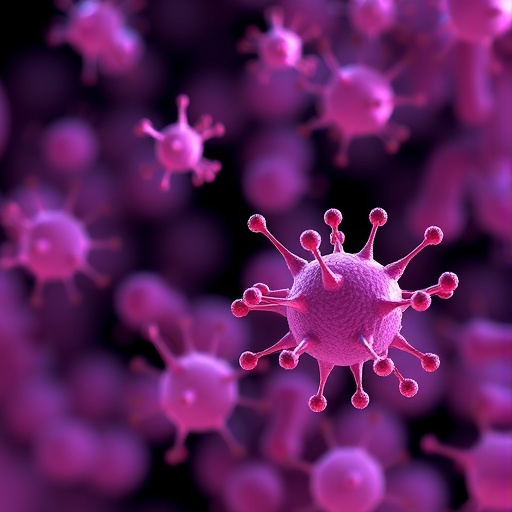In a groundbreaking study published in Nature Communications, a team of researchers led by Dillard, Glass, and Kolling has unveiled the complex metabolic interplay underpinning bacterial vaginosis (BV) using an unprecedented genome-scale metabolic network reconstruction analysis. This pioneering work provides not only fresh insights into the microbial ecology of BV but also charts a new course toward targeted therapeutic strategies that could revolutionize women’s health.
Bacterial vaginosis, a prevalent condition characterized by a dysbiotic shift in the vaginal microbiome, has long eluded precise mechanistic understanding. Traditional approaches have focused primarily on identifying microbial taxa associated with the disease state, but such taxonomic snapshots fall short of elucidating the metabolic crosstalk driving disease pathology and persistence. The current study surmounts this challenge by reconstructing genome-scale metabolic networks of BV-associated bacteria, enabling a predictive and holistic view of microbial metabolic interactions at an unprecedented resolution.
By leveraging comprehensive genomic datasets, the researchers constructed genome-scale metabolic models (GEMs) for key bacterial species implicated in BV. These models integrate enzymatic pathways, metabolite exchange capabilities, and regulatory constraints to simulate bacterial metabolism under physiological conditions. This approach marks a notable advance beyond conventional microbiome profiling by moving from mere listing of bacterial presence to precise functional predictions of metabolic activity and interaction.
What distinguishes this work is its focus on the metabolic synergy and antagonism among bacterial species within the vaginal niche. Through simulated co-culture analyses, the authors uncovered intricate networks of metabolite sharing and competition that sustain the dysbiotic community. For instance, certain anaerobic bacteria characteristic of BV demonstrate the ability to secrete short-chain fatty acids and amines, which modulate vaginal pH and promote further microbial imbalance, while concurrently scavenging essential nutrients produced by symbiotic species.
This metabolic crosstalk effectively remodels the vaginal environment, feedback mechanisms that maintain BV’s persistent state. The network models also identified key metabolic bottlenecks that could serve as potential intervention targets. Specifically, enzymes involved in amino acid catabolism and polyamine biosynthesis emerge as critical nodes within the BV-associated metabolic web, offering promising therapeutic leverage points.
Beyond mapping interspecies interactions, the study elucidates how host-derived factors influence microbial metabolism. By incorporating host metabolites and environmental parameters into their models, the researchers simulate how fluctuations in nutrient availability or immune-derived antimicrobials impact the metabolic balance of the vaginal microbiome. This systems-level perspective reveals how host-microbe metabolic interplay might contribute to disease susceptibility or resolution.
The implications of these findings extend beyond mechanistic understanding. Diagnostic methodologies could evolve from species-based biomarkers to metabolic signatures reflective of pathogenic interactions. Metabolomic profiles indicative of disrupted metabolic pathways may provide more sensitive and dynamic markers of BV onset and treatment efficacy.
Therapeutically, the identification of pivotal metabolic interactions paves the way for precision microbiome modulation strategies. Rather than broadly targeting bacteria with antibiotics—which risk collateral damage to beneficial microbes and the emergence of resistance—therapies could be designed to disrupt specific metabolic exchanges or inhibit critical enzymes, thereby restoring a healthy microbial equilibrium.
Furthermore, the research underscores the potential of integrating metabolic modeling into clinical microbiology and personalized medicine. By iteratively refining GEMs with patient-derived metagenomic and metabolomic data, individualized metabolic landscapes could be charted, guiding bespoke interventions tailored to unique microbial ecosystems.
From a technical standpoint, the study harnesses cutting-edge computational tools, including flux balance analysis and constraint-based modeling, enhanced by machine-learning algorithms to optimize model accuracy and predictive power. The integration of multi-omic datasets—genomic, transcriptomic, metabolomic—enables a multidimensional portrayal of microbial communities, transcending traditional siloed approaches.
This research also highlights the importance of community-wide metabolic dependencies and cross-feeding relationships. For example, the production of biogenic amines by BV-associated bacteria not only alters the local chemical milieu but also facilitates synergistic interactions that exacerbate inflammation and symptomatology, underscoring the complexity of microbial ecosystem dynamics.
Such intricate metabolic choreography speaks to the limitations of standard clinical treatments and beckons new paradigms that consider the metabolic fabric of microbial communities. The findings prompt a reevaluation of how microbial ecology principles can be harnessed to engineer microbiome-targeted therapies that are both effective and sustainable.
Intriguingly, the study opens avenues for exploring how lifestyle factors such as diet, hormonal fluctuations, and sexual activity modulate vaginal microbial metabolism, potentially influencing BV risk and recurrence. Future research may integrate these variables into metabolic models, fostering a more holistic appreciation of disease etiology.
Moreover, the research sets a precedent for applying genome-scale metabolic network reconstruction to other polymicrobial disorders, demonstrating the versatility and power of this approach in unraveling complex host-microbe interactions across diverse clinical contexts.
In sum, Dillard and colleagues’ landmark study redefines the frontier of microbiome science by illuminating the metabolic foundations of bacterial vaginosis. This work not only deciphers the biochemical crosstalk that sustains this enigmatic infection but also lays the groundwork for next-generation diagnostics and therapeutics that hold promise for transforming women’s reproductive health worldwide.
As the field moves forward, integrating such computational frameworks with experimental validation and clinical trials will be crucial to realizing the full potential of metabolic network-guided microbiome medicine. This study exemplifies how interdisciplinary endeavors bridging microbiology, bioinformatics, and systems biology can yield transformative insights with tangible health impacts.
Subject of Research:
Genome-scale metabolic network reconstruction to elucidate metabolic interactions associated with bacterial vaginosis.
Article Title:
Genome-scale metabolic network reconstruction analysis identifies bacterial vaginosis-associated metabolic interactions.
Article References:
Dillard, L.R., Glass, E.M., Kolling, G.L. et al. Genome-scale metabolic network reconstruction analysis identifies bacterial vaginosis-associated metabolic interactions. Nat Commun 16, 4768 (2025). https://doi.org/10.1038/s41467-025-59965-y
Image Credits: AI Generated




